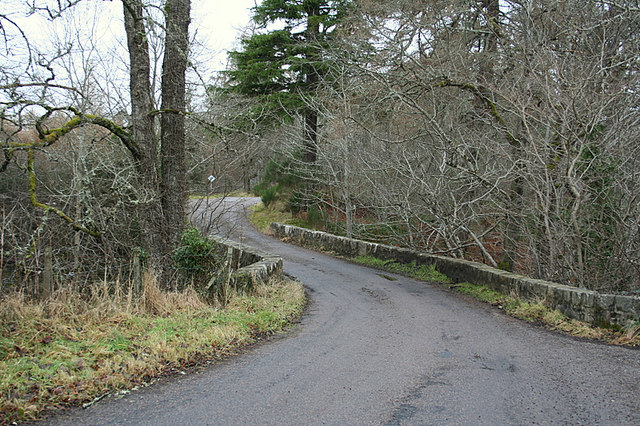Who was John MacKenzie, farmer of Drum of Clunes, and is he related to us?
I found an interesting paragraph in an online extract of a book called Whisky, Wars, Riots and Murder: Crime in the 19th Century Highlands and Islands by Malcolm Archibald while searching for information about our McKenzie ancestors in Cawdor. I have no proof that it is our John MacKenzie who is mentioned, but there is some reasonably credible evidence that he could be the uncle of our James Mann McKenzie. If he isn't a close relative, he - and the circumstances of his death - would certainly have been known to our ancestors who were living in the area at the time.
If he is 'our' John McKenzie, this is how he fits in: (See previous post for same information.)
Duncan Mackenzie, labourer, married Anne Macarthur (born in Ardclach, Nairnshire) on 10 August 1768 at Cawdor Parish Church, Cawdor, Nairnshire. They had 5 known children - all born at Andrain (a small farmstead very near to Drum of Clunas and Mains of Clunas farmsteads): Duncan, Peter, Jean, James, and John, born 3 February, 1787. Our family line is descended from oldest son, Duncan - who is the father of James Mann McKenzie, who brought his family to New Zealand in 1842.
I have found no further details of John McKenzie/MacKenzie but have strong suspicions that he could be the same person mentioned in the article below. At the time of his death, he would have been 34 years old - old enough to have a son capable of accompanying him walking a reasonable distance. The article says he was a farmer at Drum of Clunas, which is the neighbouring farmstead of Andrain, where he was born. James Mann McKenzie and his wife Ann (born McLean) were living at Drum of Clunas by 1828, when their first child, daughter Elizabeth McKenzie was born. There were also other members of the extended Mackenzie family living in other neighbouring farmsteads. If John was obviously very involved in the illicit distilling and/or smuggling of whisky, it can be reasonably assumed that other members of the extended family would also have been involved. Somewhere, I found (but cannot locate at the moment) a reference to our James McKenzie in Greenock in 1841 (the census?) with his occupation listed as a spirits merchant - which would seem to fit the extended family's possible connection with whisky (even though he was a carpenter as his 'day job').
But first, some background context:
In 1707, the unpopular English system of customs duties and excise was introduced to Scotland. Poverty, and a high tax on the essential ingredient of malt, helped spur the proliferation of illegal distilleries - without a licence - and the transport and distribution of their product. Smuggling (tobacco, wine, spirits - but mostly whisky) boomed as a consequence and was barely regarded as a crime locally, with corrupt officials just as likely to be involved in, partaking of, or benefitting from, the illicit activities to some degree.
 |
Landseer's painting "The Highland Whisky Still" about 1820 - the time of the murder of John MacKenzie. The painting portrays the illicit Highland distilleries, often hidden away in caves in difficult-to-access areas. Note the entire family involvement.
|
Government officials tried to suppress the illegal trade, and excise men - or gaugers- were constantly on the lookout for, or following information on, the illegal trade. Excise men received bonuses for the amount of seizures they made; however, it was in their best interests of long-term job security to avoid the complete removal of the whisky trade. It was a dangerous job in an area that was rugged, remote, poorly roaded and sparsely populated, and they were constantly under threat of being attacked.
Whisky production and smuggling was usually an entire family or community enterprise, and the women were certainly capable of actively supporting and protecting the industry. It was known that the wives of smugglers sometimes exchanged whisky or farm produce with the wives of excisemen for information on future operations, and some excise men could be bribed. By early 1800s, illegal whisky distilling was accepted as the only means of paying rent for a farm and was a way of life for many Highland families and communities. There as a unique code of loyalty in the Highlands - once a man had drunk whisky with smugglers, he would never betray them.
The illegal production and distribution of whisky had virtually died out by the mid-1800s. The excise men had become more efficient, the cost of licences to distill whisky legally were lowered, and pressure was put on landowners to evict tenants illegally distilling whisky.
(Note: Peat reek is whisky distilled over a peat fire.)
Depending on the route taken, Nairn to Drum of Clunas/Clunes is a 2 - 3 hour walk. Drum of Clunes/Clunas is southwest of Clunas, very near the lake (Clunas Reservoir) which was not their in the time of our ancestors (opened in 1972).
Here's a link to a short film called "Peat Reek" about the illicit whisky enterprise and set in the early 1800s in the Highlands of Scotland. It gives a very real portrayal of the place whisky distilling had in the survival of Highlands communities. It's a delightful movie (26 minutes long) and well worth a visit.















